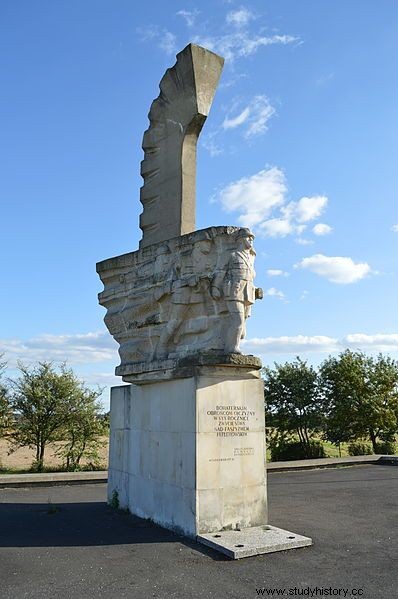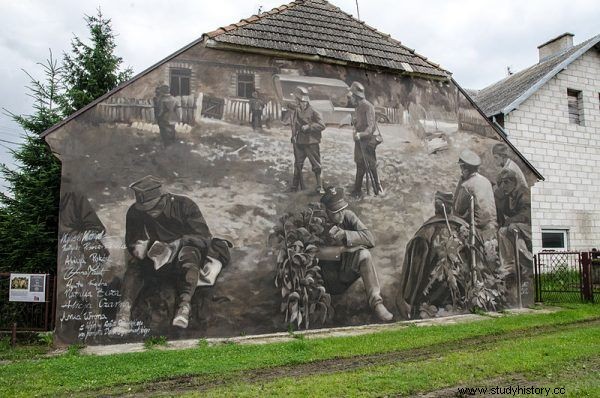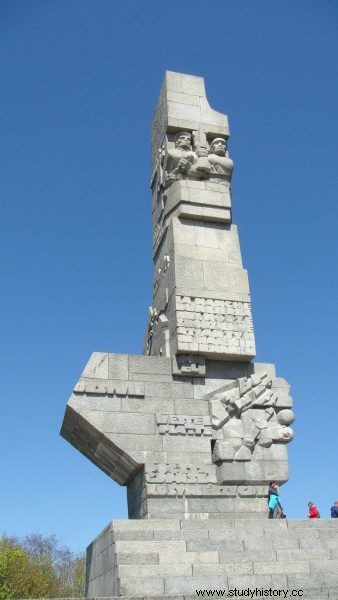The defense activities of Poles in September 1939 were doomed to failure from the very beginning. But although the Germans had a huge advantage in numbers and equipment, the conquest of our country did not come without problems. We present a subjective selection of the ten most important clashes in which our compatriots showed insane courage and heroism.
1. Battle of Bzura
The biggest battle fought during the German offensive lasted from 9 to 18 September. Historians divide it into three stages:the attack on Stryków (until September 12), Łowicz (until September 16) and the retreat, during which the Poles were finally destroyed.
The armies of "Poznań" and "Pomerania" in a desperate act managed to slow down the Nazis for a while, attacking them by surprise. The Luftwaffe failed to detect the movements of Polish troops in advance, so at first it seemed that the counteroffensive had a chance of success. Ultimately, however, the losses on our side turned out to be very severe - and much greater than the German ones. About 15,000 of our countrymen were killed, 50,000 were wounded and 100,000 were taken prisoner. About 7,000 soldiers were killed on the enemy side, and 4,000 were taken prisoner. Nevertheless, the battle was hailed as a success as it managed to stop the enemy's progress for a few days, as well as destroy about 50 tanks, 20 guns and 100 cars.
2. Defense of Kępa Oksywska
In the summer of 1939, this area of about 40 square kilometers was the base of the fleet of the Second Polish Republic. However, before armed clashes began, most of the forces were transferred to Hel, and Kępa Oksywska became a defensive bastion supporting the peninsula.
On September 10, after several days of heavy fighting in the area of Reda and Gdynia, the commander of the Land Defense of the Coast, Colonel Stanisław Dąbek, decided to transfer the burden of defensive operations to the area of Kępa Oksywska. At that time, about 9,000 people were sent there. soldiers (under-armed), as well as many civilians. The resistance from the Poles was so strong that the Germans needed another nine days to capture the bastion. However, the balance of the fights was tragic. He died, among others Colonel Dąbek, who on the last day of the siege rushed into battle with 20 officers remaining with him. Injured with a mortar shell, he took his own life on the battlefield.
3. Battle of Mokra
It was one of the first clashes of World War II. The Volyn Cavalry Brigade under the command of Colonel Julian Filipowicz blocked the progress of General Reinhardt's 4th Armored Division throughout the day.
The German leader did not realize that he was fighting with the entire brigade, so initially he sent only one regiment ahead, which was literally defeated by Filipowicz's troops. The retreating tanks broke the morale of the German troops, and the Nazi leadership had to regroup. Later, the Germans attacked four more times, but failed to achieve their goal.
However, the success of our compatriots was not complete. After dark, the Poles retreated. The enemy decided to take advantage of this and decimated the maneuvering soldiers. The losses on the Polish side amounted to 530 soldiers, 5 guns and 4 anti-tank guns, the Germans "cost" over 100 tanks, several armored cars and several hundred soldiers.

Monument commemorating the battle of Mokra
4. A trip to Wschowa (Fraustadt)
This action was organized by General Roman Abraham, commander of the Greater Poland Cavalry Brigade. On his orders, the 55th Poznań Infantry Regiment stationed in Leszno crossed the border of the Third Reich on September 2 and attacked the town of Fraustadt (today's Wschowa).
The operation of the Poles caused great confusion. The German command even considered the evacuation of the civilian population. A successful offensive definitely improved the morale of the Second Polish Republic. Nevertheless, from a strategic point of view, the attack was virtually irrelevant. Anyway, the fighting was quickly abandoned so as not to weaken the garrison in Leszno unnecessarily.
5. Defense of Wizna
During the defense of the section of the front based on the Narew River near Wizna, Polish soldiers made a heroic effort. It is hardly surprising that the battle currently fought on September 7-10 is referred to as the "Polish Thermopylae".
Our compatriots managed for two days to hold back the majority of German troops in numbers and equipment. Only 350 soldiers and 20 officers were stationed in the few shelters on the side of the defenders, while the Nazis had 42,000 people equipped with tanks and various types of guns. The Nazis also had the support of the Luftwaffe, commanded by General Hanz Guderian, creator of the term blitzkrieg.
Nevertheless, the last stronghold of defense did not fall until September 10, when a German emissary appeared and offered to surrender on good terms. Captain Władysław Raginis, who commanded the troops, agreed, but when his subordinates left the fortifications, he burst himself with a grenade.

A mural depicting the soldiers of Captain Władysław Raginis on the wall of one of the houses in Wizna.
6. Fight near Kaluszyn
According to historians, the battle fought on the night of September 11-12 was one of the bloodiest during the defensive war. The Polish army attacked the Germans as they regrouped and prepared for a further offensive. Colonel Stanisław Engel gave the order for a surprise attack. Our soldiers flanked the enemy until dawn and inflicted such severe losses on him that he had to withdraw. It was a great defensive success for Poland, because the Germans did not manage to recapture Kałuszyn until September 24.
The 1st Legions Infantry Division broke the German encirclement in this Mazovian town, at the same time achieving one of the few victories of Poles during the September campaign. Lieutenant Andrzej Żyliński, commanding the unit, recalled that during the charge:"The Germans ran away like rabbits through fences into gardens and orchards."
7. Border Battle
Today, historians believe that the attempt to stop the Nazi offensive in the first days of September on the border of the country, and not on the line of the Vistula, was not very reasonable. Nevertheless, such a decision of the command of the Polish Army was primarily of a political nature - in this way they wanted to show that it is impossible to take over the Second Polish Republic so easily. The goal was achieved - partially - because as a result England and France joined the war. On September 3, however, the Poles had to surrender and withdraw into the country.
8. Defense of Westerplatte
This is where it all started. On September 1, 1939, at 4:45 a.m., the battleship Schleswig-Holstein opened fire towards Westerplatte. Over the next week, the defenders repelled several strikes and organized several forays, inflicting heavy losses on the aggressors. Unfortunately, their sacrifice turned out to be futile.
The last act of defense took place on September 7, when the attacking Germans were shot at once again. They set fire to the surrounding forests and attacked with twenty times more numbers. Finally, the decision to surrender was made, and Major Henryk Sucharski began negotiations. Nevertheless, Westerplatte is still a symbol of the heroism of Poles who shed their blood for their homeland in September 1939. Even the commanding officer of the German troops, General Friedrich Eberhardt, expressed his appreciation for the bravery of our countrymen.

Monument to the Defenders of the Coast
9. The Battle of Kock
The Battle of Kock, fought in the first week of October, was the last clash of the defensive war. While the situation was hopeless, the fighting was fierce. The operational group "Polesie" was active under the command of General Franciszek Kleeberg. This formation made its way from Brześć to Dęblin, where the leader hoped to replenish the rapidly dwindling ammunition, when he encountered the outpost of the 13th Motorized Division of the Wehrmacht.
At first, the Poles were on the offensive, inflicting heavy losses on the enemy, but soon the German forces managed to regroup and respond with fire. Among the fighters under the leadership of Kleeberg was the writer and reporter Marian Brandys, who described the events of October 5, during the capture of Wola Gołuchowska:"Caught in the amok of the battle, deafened by the roar of gunfire and our own scream - through the sweat flooding our eyes we only saw the white church that we were supposed to conquer" .
The surprise attack was successful, but at the decisive moment the soldiers of Polesie ran out of ammunition. They capitulated on October 6.
10. Defense of the Hel Peninsula
During the defense of the Coast, the Hel crew was the last to capitulate on 2 October. Before that, however, she had fought intense battles. The Germans launched the Grenzchutz Abschnitts Komando 1 corps under the command of General Leonard Kaupisch to attack the coast. In total, 39 thousand people attacked our countrymen. soldiers equipped with 470 heavy machine guns, 186 field guns, 140 cannons and 100 mortars.
On the Polish side, the only air squadron in the country (practically unable to fight at the time), as well as ships grouped in two strategic places, defended themselves. Despite the huge advantage of the Germans and the lack of hope for support, the defenders remained in their posts for a month and fought for a few more days after the capitulation of Warsaw. However, the fate of the Second Polish Republic was sealed. The Battle of Kock and the last uprisings of soldiers on the Hel Peninsula ended the organized defense activities of Poland after the attack of Nazi Germany.
